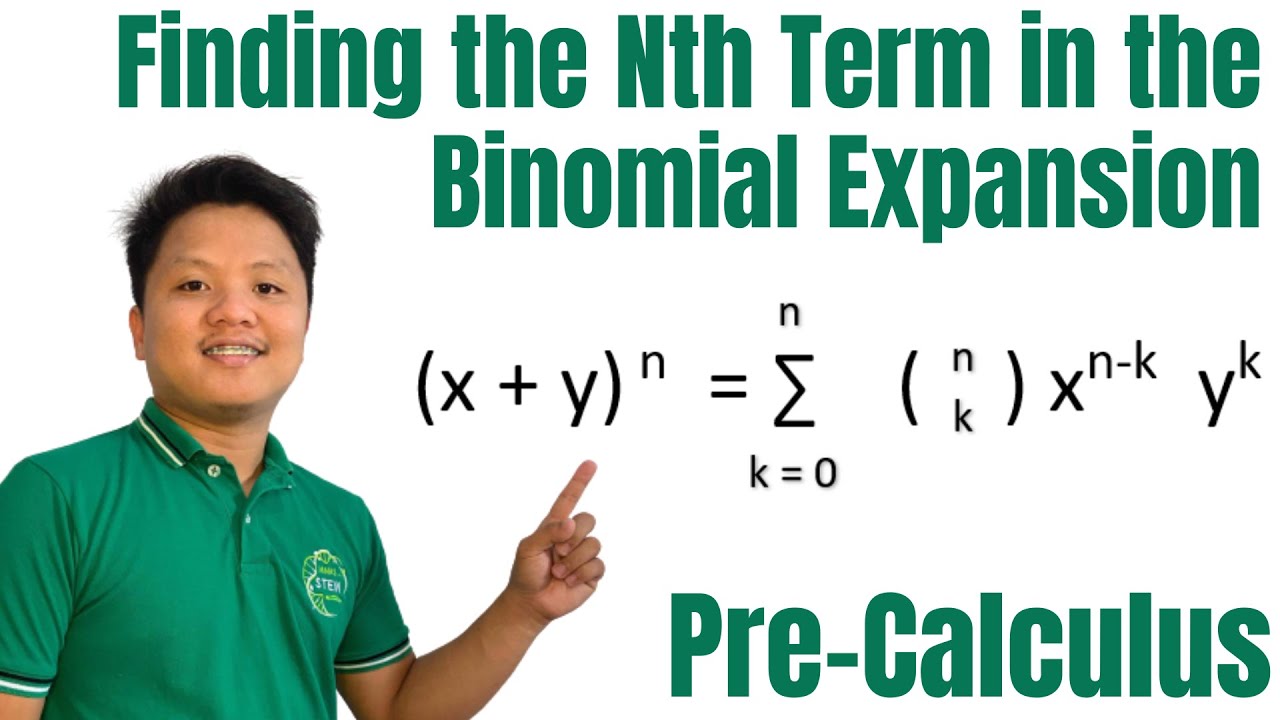Binomial Theorem (part 2)
TLDRThis video script explores the binomial theorem, offering a method to simplify the process of expanding expressions like (a + b)^n for large n. Initially, it explains the tedious nature of polynomial multiplication and introduces the binomial theorem with binomial coefficients. The script then presents Pascal's triangle as a visual tool to quickly find these coefficients. Finally, it introduces a faster method to compute the coefficients without memorization, by using a systematic approach based on the pattern of coefficients in the binomial expansion, which can significantly speed up the process of expanding binomials to high powers.
Takeaways
- 📚 The script discusses the complexity of manually expanding binomial expressions like (a + b)^n for large values of n, especially beyond 3.
- 📐 The binomial theorem is introduced as a more efficient method to expand such expressions, involving the sum of terms with binomial coefficients.
- 🔢 The binomial coefficient, also known as 'n choose k', is explained as the key to the binomial theorem, representing the coefficients in the expansion.
- 📈 A faster method to compute binomial coefficients is introduced using Pascal's triangle, which is a triangular array of numbers where each number is the sum of the two numbers above it.
- 📊 Pascal's triangle is shown to generate the coefficients for the binomial expansion of (a + b)^n quickly and without complex calculations.
- 📉 The script provides a step-by-step guide to using Pascal's triangle to find the coefficients for (a + b)^4 as an example.
- 🎯 An even faster method is hinted at for calculating binomial coefficients, which involves understanding the pattern and symmetry in Pascal's triangle.
- 📝 The script demonstrates how to use the numbers 1 through 11 to quickly determine the coefficients for (x + y)^10 using a pattern-based approach.
- 🧩 The method involves recognizing the symmetry in the binomial expansion and using a simple arithmetic pattern to find coefficients without full expansion.
- 🔄 The process is shown to be iterative, starting from the first term and building up to the middle term, after which the coefficients decrease symmetrically.
- 🚀 The final part of the script promises to show an even more efficient method in a future video, suggesting a level of mastery that could allow for mental calculations of binomial expansions.
Q & A
What is the main topic discussed in the video script?
-The main topic discussed in the video script is the binomial theorem and methods to compute binomial coefficients efficiently, particularly for higher powers.
Why is it challenging to expand (a + b)^n using polynomial multiplication when n is larger than 3?
-It is challenging because it involves a lot of repetitive multiplication and becomes extremely tedious, especially as the power n increases.
What is the binomial theorem and how does it simplify the expansion of (a + b)^n?
-The binomial theorem states that (a + b)^n is equal to the sum of terms from k=0 to n of 'n choose k' multiplied by a^(n-k) * b^k, which simplifies the expansion by avoiding the need for manual polynomial multiplication.
What is the binomial coefficient and why is it significant in the binomial theorem?
-The binomial coefficient, often represented as 'n choose k', is a number that represents the number of ways to choose 'k' elements from a set of 'n' elements. It is significant in the binomial theorem as it provides the coefficients for each term in the expansion.
How does Pascal's triangle relate to the binomial coefficients?
-Pascal's triangle is a triangular array of numbers where each number is the sum of the two numbers directly above it. The numbers in Pascal's triangle are the binomial coefficients, which can be used to quickly determine the coefficients for the expansion of (a + b)^n.
What is the 'pseudo fast way' mentioned in the script for computing binomial coefficients?
-The 'pseudo fast way' refers to using Pascal's triangle to generate binomial coefficients without having to compute them manually, which is faster and more efficient.
Can you explain the symmetry in Pascal's triangle and its significance?
-The symmetry in Pascal's triangle means that the numbers read the same from left to right as from right to left. This symmetry is significant because it reflects the commutative property of addition, i.e., a + b = b + a, and it simplifies the computation of binomial coefficients.
What is the alternative method introduced in the script for computing binomial coefficients quickly?
-The alternative method introduced is a trick where you start with a sequence of numbers representing the terms of the binomial expansion and then calculate the coefficients based on the position of the term and the exponent of 'x' or 'a', without having to draw Pascal's triangle or compute 'n choose k'.
How does the script suggest to calculate the coefficients for the terms in the expansion of (x + y)^10?
-The script suggests starting with a sequence of numbers from 1 to 11, representing the terms, and then calculating each coefficient based on the exponent of 'x' or 'a', the previous coefficient, and the term's position in the sequence.
What is the advantage of using the method described in the script over traditional polynomial multiplication?
-The advantage is that it allows for a much faster computation of binomial coefficients, especially for high powers, and it reduces the likelihood of making errors that can occur with manual polynomial multiplication.
Outlines
📚 Introduction to Binomial Theorem and Pascal's Triangle
The script begins by discussing the complexity of expanding expressions like (a+b)^n when n is greater than 2, especially beyond 3. It highlights the utility of the binomial theorem as a more efficient alternative to manual polynomial multiplication. The binomial theorem is presented with its formula, emphasizing the binomial coefficient, which is derived from combinatorics. The script then introduces a faster method of computing these coefficients using Pascal's Triangle, a triangular array of numbers where each number is the sum of the two numbers directly above it. The process of constructing Pascal's Triangle is demonstrated, and it is shown how it can be used to quickly determine the coefficients for the expansion of (a+b)^n, up to the fourth power in this example.
🔍 Expanding Binomials Using Pascal's Triangle
The second paragraph continues the discussion on Pascal's Triangle, illustrating how it can be used to find the coefficients for the binomial expansion of (a+b)^n, this time up to the fifth power. It explains the process of drawing out the triangle and using it to determine the coefficients for each term in the expansion, which can be done relatively quickly and without complex calculations. The script notes that while this method is efficient for powers up to eight or nine, it can become cumbersome for higher powers due to the space required and the potential for errors. It also hints at an even faster method to be introduced later in the script.
🚀 A Rapid Method for Computing Binomial Coefficients
In the final paragraph, the script introduces an advanced technique for computing binomial coefficients, which allows for the rapid expansion of binomials to high powers, almost mentally. It uses a concrete example, (x+y)^10, to demonstrate this method. The process involves writing down the powers of x and y that will appear in the expansion and then determining the coefficients for each term. The script explains a systematic approach to finding these coefficients, which involves using the exponent of the term, multiplying it by the coefficient of the previous term, and then dividing by the term's position in the sequence. This method is shown to be symmetric and efficient, allowing for quick computation of the coefficients without the need for extensive calculations or drawing out Pascal's Triangle.
Mindmap
Keywords
💡Binomial Theorem
💡Combinatorics
💡Binomial Coefficient
💡Pascal's Triangle
💡Distributive Property
💡FOIL
💡Arithmetic
💡Exponent
💡Coefficient
💡Symmetry
Highlights
The binomial theorem simplifies the process of raising a binomial to a power, especially when the power is larger than 3.
The binomial theorem states that (a+b)^n equals the sum of terms from k=0 to n of 'n choose k' times a^(n-k) times b^k.
The binomial coefficient 'n choose k' is derived from combinatorics and represents the coefficients in the binomial theorem.
A faster method to compute binomial coefficients involves using Pascal's triangle, which is a triangular array of numbers where each number is the sum of the two numbers above it.
Pascal's triangle can be used to quickly determine the coefficients for the expansion of (a+b)^n without complex calculations.
The coefficients in Pascal's triangle are symmetric, reflecting the commutative property of addition (a+b = b+a).
An example is given to illustrate the process of using Pascal's triangle to find the coefficients for (a+b)^4.
The video demonstrates an even faster method to compute binomial coefficients without memorization, suitable for high powers.
The method involves writing down the powers of 'x' and 'y' and then determining the coefficients using a systematic approach.
The coefficients are calculated by multiplying the previous coefficient by the current exponent and dividing by the term's position.
The video provides a step-by-step calculation for the coefficients of (x+y)^10 as an example of this method.
The symmetry of the binomial coefficients is utilized to simplify the calculation process after reaching the middle term.
The method allows for quick computation of binomial expansions, even for high powers like the 10th power.
The video suggests practicing this method to be able to compute binomial expansions almost instantaneously.
The presenter hints at doing another video with a smaller example to demonstrate the method's simplicity for lower powers.
Transcripts
Browse More Related Video

Binomial Theorem (part 1)

Binomial Expansion Using Pascal's Triangle | Pre-Calculus

Binomial theorem combinatorics connection | Algebra II | Khan Academy

A Secret Weapon for Predicting Outcomes: The Binomial Distribution

Finding the Nth Term in the Binomial Expansion | Binomial Theorem | Pre-Calculus

BINOMIAL THEOREM || PRE-CALCULUS
5.0 / 5 (0 votes)
Thanks for rating: